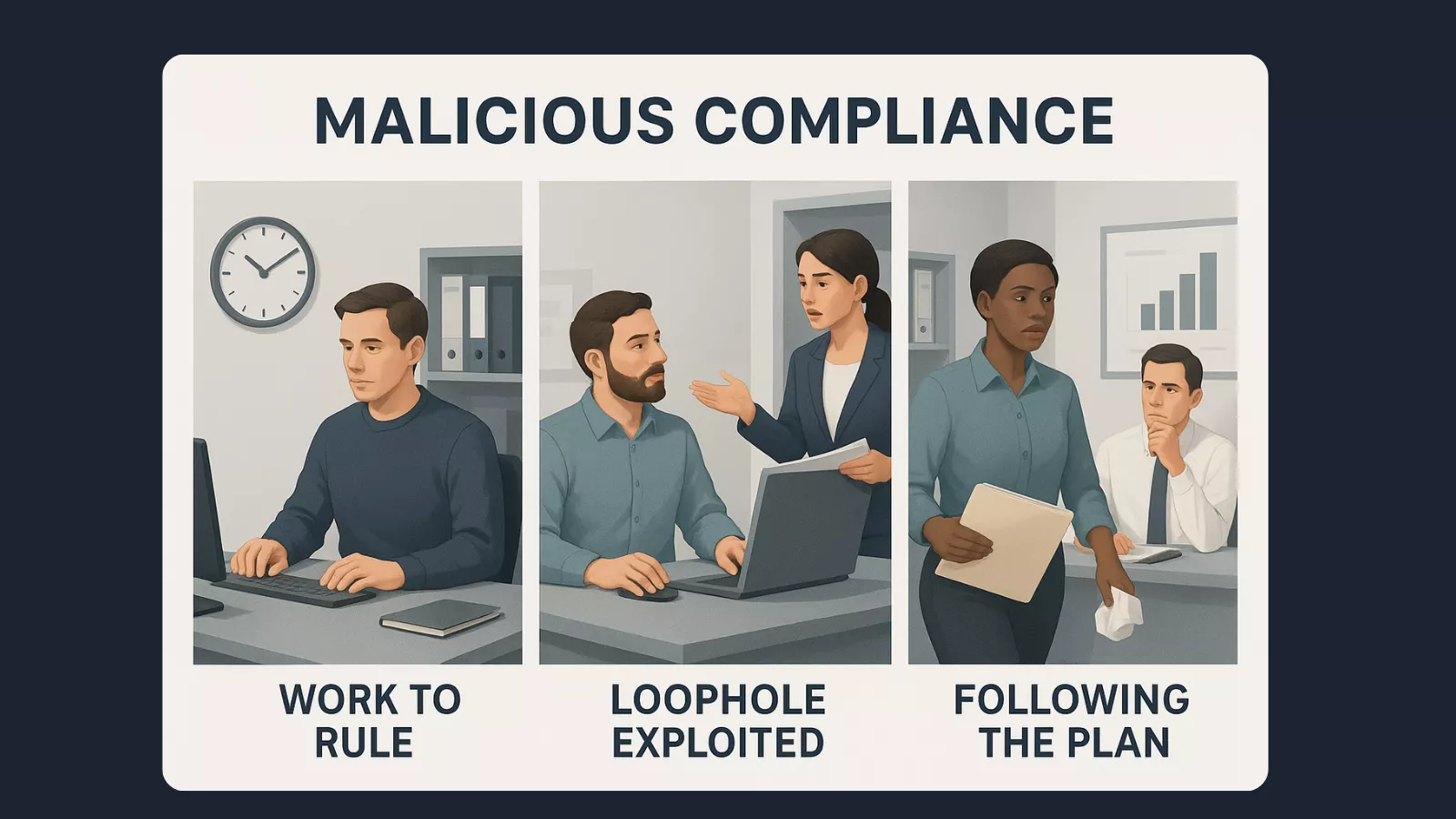
Every workplace runs on structure — policies, procedures, and clear lines of authority. These systems are designed to bring order, consistency, and fairness. But sometimes, they can also backfire in unexpected ways. One such example is malicious compliance — a subtle yet powerful form of workplace rebellion where employees follow the rules to the letter, even when it causes disruption or inefficiency.
For managers and HR leaders, malicious compliance can be tricky to identify and even harder to manage. On the surface, employees appear to be obeying instructions. But underneath, their actions may reflect frustration, disengagement, or even silent protest against unfair leadership or flawed company policies.
Let’s dive deeper into “what is malicious compliance,” how it manifests in organizations, and how businesses can prevent it before it starts affecting culture, productivity, and morale.
Listen To The Podcast Now
What Is Malicious Compliance?
Malicious compliance occurs when employees deliberately follow instructions, rules, or policies exactly as stated — knowing full well that doing so will lead to negative consequences. It’s a subtle form of resistance that exposes flaws in management decisions or company systems without breaking any official rules.
In simpler terms, it happens when workers say, “You asked for this, so I did exactly what you said.” The intent is not to improve processes but to highlight how impractical or unreasonable those processes are.
For example, if a manager insists that all emails must go through a lengthy approval chain before sending, an employee might strictly follow that rule — even for urgent messages — causing unnecessary delays just to demonstrate how inefficient the policy is.
Malicious compliance is not open defiance. Instead, it’s a passive-aggressive form of protest that allows employees to maintain technical compliance while revealing deeper problems within the organization.
Why Does Malicious Compliance Happen at Work?
Malicious compliance rarely happens in a vacuum. It’s often a reaction to poor communication, rigid policies, or a lack of trust between management and employees. Understanding what triggers this behavior is the first step toward addressing it.
1. Frustration With Authority
When employees feel micromanaged or disrespected, they may follow directions too literally to expose how unreasonable or out-of-touch those directions are. This becomes their way of regaining some sense of control in an environment where they feel powerless.
2. Lack of Autonomy
In workplaces where decision-making is overly centralized, employees may feel they have no say in how their work gets done. It becomes a form of rebellion — they comply to the point of dysfunction, forcing management to notice the flaws in the system.
3. Poor Communication
Vague, confusing, or contradictory instructions can create frustration. When expectations aren’t clear, employees may stick strictly to what’s written, even when common sense says otherwise. This literal compliance highlights communication gaps and inefficiencies.
4. Disengagement and Burnout
When employees no longer feel emotionally connected to their work, they stop thinking critically. They do exactly what’s asked of them — nothing more, nothing less. Malicious compliance can be a symptom of burnout or quiet quitting, signaling that employees have stopped caring about outcomes.
5. Exposing Flawed Policies
Sometimes employees use malicious compliance to highlight broken systems. By following a bad policy to the letter, they demonstrate how impractical it is — forcing management to confront and revise it.
6. Revenge or Recognition
When hard work goes unnoticed or unfair treatment becomes the norm, some employees resort to compliance as payback. They’re technically doing their jobs, but in a way that makes leadership face the consequences of its own decisions.
In short, it is often a symptom of deeper organizational issues — not a cause. Recognizing the “why” behind this behavior is crucial to preventing it from spreading.
Malicious Compliance Examples

Understanding real-world malicious compliance examples helps HR teams identify similar patterns in their own organizations.
Example 1: The PTO Dilemma
An employee requests vacation leave, but their manager denies it due to staffing shortages. In response, the employee strictly follows the rule allowing PTO requests with just one week’s notice. They later file for extended leave during the busiest period — fully within policy — leaving the company scrambling for coverage.
Example 2: The Dress Code Rule
A company enforces a “formal dress code” policy, even for remote meetings. Frustrated employees start showing up in full suits — jackets, ties, and all — during virtual calls, even in extreme heat. The absurdity of the situation soon forces leadership to reconsider the rule.
Example 3: The Customer Service Incident
A support team is told to follow scripts exactly during customer calls. When a frustrated customer demands flexibility, the agent sticks to the script word-for-word, prolonging the issue. The result? Management realizes that robotic adherence to policy damages the customer experience.
These examples may sound amusing, but their impact on morale, productivity, and trust can be severe if left unaddressed.
The Impact Of Malicious Compliance In the Workplace
At first glance, malicious compliance may seem harmless — just employees doing their jobs as instructed. But beneath the surface, it’s a signal of cultural and operational breakdown. Here’s how malicious compliance in the workplace can hurt your business:
1. Loss of Productivity
When employees focus on following rules rather than outcomes, projects slow down. Tasks that should take hours stretch into days, creating bottlenecks across teams.
2. Decline in Morale
A culture of frustration and passive resistance spreads quickly. When one employee starts complying maliciously, others may follow suit, leading to widespread dissatisfaction.
3. Customer Frustration
Employees who prioritize strict policy adherence over service flexibility can alienate clients or customers, directly affecting the company’s reputation and bottom line.
4. Increased Turnover
No one enjoys working in an environment where common sense is ignored. Over time, top performers may leave, seeking workplaces that value trust and communication.
5. Legal and Financial Risks
Blindly enforcing bad policies can lead to regulatory violations, contractual breaches, or even lawsuits if customers or employees are negatively affected.
6. Erosion of Trust
When leadership enforces rigid rules without considering feedback, employees stop believing their opinions matter. Once trust is gone, rebuilding it takes time and effort.
In short, it doesn’t just slow operations — it weakens the foundation of company culture.
How To Identify Maliciously Compliant Behavior?
Recognizing a maliciously compliant employee isn’t always easy, because on paper, they appear to be following the rules. However, subtle patterns often reveal their true intent:
- Tasks are done exactly as requested, with no initiative or flexibility.
- Work quality drops without breaking formal standards.
- Employees begin referencing “policy” excessively to justify inefficiencies.
- Communication becomes overly literal or defensive.
- Team collaboration decreases, and feedback loops close down.
If multiple employees start behaving this way, it’s often a sign of larger systemic frustration — not individual disobedience.
Strategies To Prevent Malicious Compliance
Preventing malicious compliance requires more than strict oversight — it demands trust, communication, and flexibility. Here’s how HR and leadership can address the issue proactively:
1. Listen to Employees
It often starts when employees feel ignored. Create open channels for feedback — through one-on-one sessions, surveys, or town halls — and genuinely act on what you hear.
2. Simplify and Review Policies
Audit your policies regularly. Outdated or contradictory rules create confusion and resentment. Make sure company policies align with both business goals and employee needs.
3. Encourage Autonomy
Give employees room to make decisions within reasonable boundaries. When people feel trusted to think for themselves, they’re less likely to hide behind rigid compliance.
4. Promote Psychological Safety
Employees should feel safe voicing disagreement without fear of punishment. When they can challenge policies openly, they won’t need to use compliance as a protest.
5. Train Managers in Communication
Often, malicious compliance begins with unclear or inconsistent instructions. Train managers to communicate expectations clearly and to clarify misunderstandings before they escalate.
6. Recognize Effort, Not Just Obedience
Reward initiative, creativity, and problem-solving — not just adherence to process. This reinforces a results-oriented culture over a rule-bound one.
7. Monitor for Early Warning Signs
EmpCloud can help identify sudden changes in behavior — such as drops in engagement, communication patterns, or task performance — that may indicate growing dissatisfaction or passive resistance.
The Role of Leadership in Managing Malicious Compliance
Leadership plays a defining role in preventing malicious compliance at work. The tone set by management determines whether employees feel empowered or restricted.
Great leaders:
- Communicate clearly and empathetically.
- Explain the “why” behind decisions, not just the “what.”
- Are open to feedback, even when it challenges their assumptions.
- Build systems where flexibility and fairness coexist.
When leaders model accountability and respect, employees reciprocate with transparency and trust — creating a workplace where malicious compliance has no room to grow.
Legal And Ethical Dimensions of Malicious Compliance
While malicious compliance itself isn’t illegal, it can easily cross ethical or legal lines if it causes harm or violates external regulations. For example:
- Rigidly enforcing flawed safety policies could result in workplace accidents.
- Following discriminatory rules may expose the company to lawsuits.
- Overly literal interpretations of client contracts can breach obligations.
HR professionals must ensure that all company policies comply with labor laws, safety standards, and ethical norms. Continuous audits and open communication between HR and employees can help avoid costly missteps.
Once businesses recognize these compliance pitfalls, the next step is adopting smarter tools and strategies that reinforce clarity, trust, and consistent policy adherence.
How EmpCloud Can Help HR Tackle Malicious Compliance?
Curbing malicious compliance begins with visibility, communication, and trust — all of which thrive when backed by the right technology. EmpCloud empowers organizations to manage teams effectively, monitor productivity, and encourage healthy accountability. With its suite of intelligent tools, businesses can maintain operational clarity and prevent the kind of miscommunication or disengagement that often leads to malicious compliance.
Here’s how EmpCloud supports a more transparent and performance-driven work environment:
- Time Tracking
Optimize productivity with precise monitoring of work hours and activities. Ensure every task is accounted for while maintaining clarity between effort and outcomes. - Geo-Location Tracking
Keep track of field team locations in real time to ensure smooth coordination, verified client visits, and efficient operations. - Manage Tasks & Opportunity
Assign tasks effortlessly, monitor progress in real time, and ensure that projects stay aligned with business objectives and deadlines. - Client Management
Organize and track all client interactions from a unified dashboard, improving service quality and maintaining stronger professional relationships. - Productivity Tracking
Gain actionable insights into employee performance, identify productivity patterns, and make data-backed decisions to improve workflow efficiency. - Project Management
Strategically plan, oversee, and manage projects from start to finish — ensuring timely delivery and balanced team workloads. - Data Loss Prevention
Safeguard critical business information with cutting-edge security measures designed to protect your organization from insider threats and data leaks. - Report Generation
Generate comprehensive reports to evaluate performance, analyze trends, and drive informed decision-making with accuracy and ease.
Conclusion
Malicious compliance isn’t about disobedience — it’s about disconnection. When employees feel unheard, untrusted, or undervalued, they follow the rules too well to prove a point. While the behavior may seem harmless, its long-term effects on morale, productivity, and culture can be damaging.
The good news? It’s entirely preventable.
By listening to employees, encouraging autonomy, and maintaining fair, flexible policies, companies can foster a culture where open communication replaces silent protest. HR leaders must see malicious compliance not as defiance, but as feedback — an opportunity to improve systems and leadership practices.
And with powerful workforce management tools like EmpCloud, businesses can stay proactive, ensuring every employee feels seen, valued, and motivated to contribute meaningfully, rather than comply maliciously.
FAQS
- Is malicious compliance considered misconduct at work?
Yes. While malicious compliance may appear as following the rules, it can be classified as misconduct if the employee intentionally causes harm or disruption to the organization. The intent behind the action often determines whether it qualifies as a policy violation. - How can HR detect signs of malicious compliance early?
HR can identify early signs through sudden changes in productivity patterns, employee behavior inconsistencies, or frequent reliance on loopholes. Monitoring tools like EmpCloud’s productivity and time tracking features can help detect unusual work trends or policy exploitation. - Can malicious compliance lead to legal consequences for employees?
In extreme cases, yes. If malicious compliance results in financial losses, data exposure, or violation of company policy, it can lead to disciplinary action or even legal proceedings, depending on organizational and regional regulations. - How is malicious compliance different from constructive feedback or dissent?
Constructive feedback aims to improve workplace efficiency through open communication, while malicious compliance uses rules as retaliation or protest. The key difference lies in the intent — feedback is solution-oriented, whereas malicious compliance is passive-aggressive.





